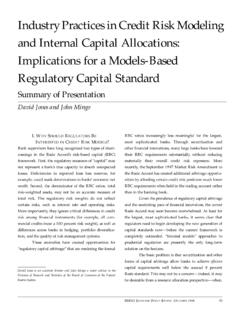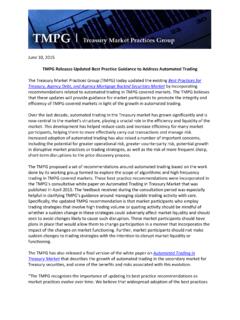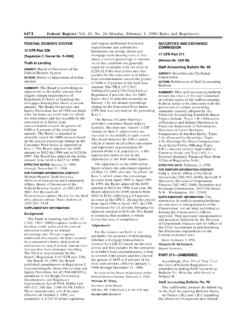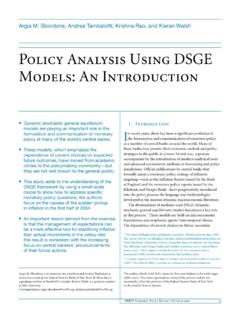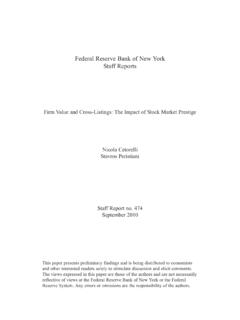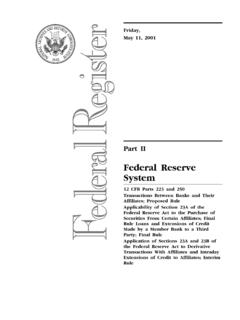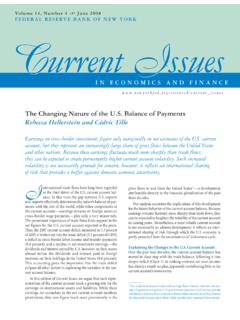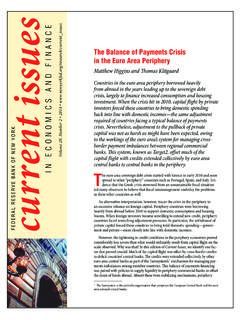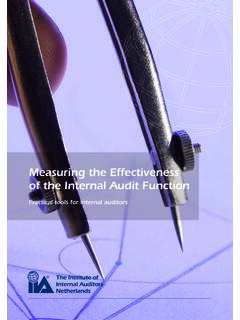Transcription of Regulatory Reporting Introduction and Overview
1 10 April 26, 2012 Regulatory Reporting Best PracticesRegulatory ReportingIntroduction andOverviewKenneth Lamar22 Objectives What are the goals of Regulatory Reporting ? Where are the pitfalls? How to mitigate these?3 Purpose of Regulatory Reports Regulatory reports are collected for many purposes: Monitoring safety and soundness on the individual legalentity level ( , Regulatory capital) Monitoring systemic risk in the banking and financialsystems Monetary Policy (measurement and operations) Cross border flows (individual exposures and position ofcountries) Compliance34 Purpose of Regulatory Reports This results in the Federal Reserve Systemcollecting: Over 80 reports Different cuts Different definitions Different consolidation rules5 Purpose of Regulatory Reports Report design focuses on The need for data balanced by cost Robust review process is in place Dialogue with the financial services industry iskey to good report design46 Pitfalls Static databases Often cause significant classification errors Business lines need to.
2 Understand the Regulatory Reporting requirements Be accountable Have open communication and partnership with theregulatory Reporting area7 Pitfalls Legal entities matter Regulatory Reporting is based on legal entities This may differ from internal business linecontrols and measurements The more complex a firm, the more difficult it is toreport by legal entity Accountability becomes difficult to identify58 Pitfalls Regulatory Reporting viewed as back officeprocess Not involved in new product development oraccounting policy This can result in misstatements and unintendedconsequences of Regulatory rules9 Pitfalls Mergers and acquisitions Always a Regulatory Reporting challenge Long term integration planning for Regulatory reportingand source system are key Communication with regulators before, after and duringthe merger/acquisition is critical Planning and communicating work around (avoidsignificant errors)610 Best Practices Automate Document Review Communicate (Ask and Learn)11 Best Practices Automation Data are only as good as their source Regulatory Reporting software should interfacewith the G/L and related subsystems Minimum manual intervention Limit the use of spreadsheets Leverage business solutions for regulatoryreporting712 Best Practices Ensure quality of static databases Are they: In line with Reporting requirements?
3 Reviewed regularly? Clear to business lines?13 Best Practices Documentation Procedures for preparing each report should beavailable Reconciliations and manual adjustments shouldbe clearly documented Accounts, products descriptions and accountingpolicies should be clear and readily available topreparers This includes reserves and valuation polices814 Best Practices Review and approval Data should be thoroughly reviewed beforesubmission (including a management review) Document reasons for unusual/significantchanges Include the ability to conduct analysis inregulatory Reporting systems 80/20 rule15 Best Practices Learning and communicating Work closely with business lines, accounting policyand audit (both internal an external) Stay apprised on accounting and Regulatory changes(even though they might not seem to affect you)
4 Speak regularly with your supervisor anddata collector Complex issues should be documented Participate in the report design process Industry Groups Federal Register Notices916 Mitigating the Impact ofReporting Changes The analysis of effect should include: What is the purpose of the request? How available are data? How are like data being used internally?17 Mitigating the Impact ofReporting Changes The analyses of the impact should include: Are there ways to collect data that would be lessburdensome? Are business lines engaged? What are the transition issues? Lead time Conflicts1018 Mitigating the Impact ofReporting Changes Resources to follow Reporting changes: FRBNY Website Federal Register Notice BIS Website Treasury Website19 What To Do After ReportingChanges Are Final? Involve all applicable business lines asearly as possible Ensure resources are available Automation resources Discuss with data collector any vague issues11 Regulatory ReportingBest PracticesPatricia Maone21 Regulatory ReportingBest PracticesObjectives Define Best Practices internal control Guidelines Accountability Data Integrity Issues1222 Regulatory ReportingBest Practices What are best practices?
5 Failure to comply with Regulatory reports Civil money penalties Legal and reputational riskInternal ControlGuidelinesPatricia Maone1324 internal control Guidelines Definition Methods and procedures to provide reasonableassurance for the accuracy of Regulatory reports 2002 Sarbanes-Oxley Act, Section 404 internal controls over financial reporting25 internal control GuidelinesControl TypeDescriptionPreventivePolicies and procedures toprevent errors. Normally appliedto individual transactions(customer information files, FX,interest rate swaps, etc.)DetectivePolicies and procedures designed todetect and correct errors that mightpreclude the achievement of therelevant process. Generallyappliedmore broadly(review and analysisof Regulatory reports).1426 internal control Guidelines control Principles Review and Approval Interpretation of Instructions Documentation Training Program Accounting Record Retention27 internal control Guidelines Review and Approval Management review and approval ofregulatory reportsAs a result of an inadequate review andapproval process.
6 Errors may be PracticeA review process of reports should be performed bya senior level to detect potential problems with control Guidelines Interpretation of Regulatory reportinginstructions Understanding of instructions-Relationship between Regulatory reportsand public financial statementsLimited understanding of Regulatory reportinginstructions and lack of reconciliation betweenreports/schedules result in inaccurate control Guidelines Interpretation of Regulatory reportinginstructionsBest PracticesReview the report specifications for allregulatory reports and compare to regulatoryreporting instructions to ensure specificationsare in compliance with the clarification of instructions in FRB control Guidelines Documentation Procedure ManualA lack of written or inaccurate procedures could result ininconsistent practices among employees and inaccurateand unreliable PracticesThe procedure manual should include:(1) Procedures for allregulatory reports;(2) Adequate descriptions for alladjustments.
7 And(3) Process to review new/complex banking productsfrom Regulatory Reporting control Guidelines Documentation Regulatory Reporting Policy Manual Provides guidelines and overall framework toensure uniformity and standardizationInadequate policies could result in inconsistentpractices leading to inaccurate Regulatory control Guidelines Training program Regulatory Reporting staff Staff responsible for providing regulatoryreporting information33 internal control Guidelines Accounting Accurate posting Adequate account review and reconciliationInadequate controls result in misstated regulatoryreports and inaccurate and unreliable PracticesEmployees are properly trained on performingaccounting accounting systems have adequate inputand processing control Guidelines Record Retention Comply with internal policies
8 And proceduresInadequate policies could result in inconsistentpractices leading to inaccurate Regulatory Integrity Issues Data integrity issues Inter-company (related party transactions) Systems integration/interface issues Reconciliations Incorrect use of G/L accounts by business linesor cost centersBest PracticeManagement should ensure the integrityof information by enforcing Maone37 Objectives Accountability Data Ownership Corrective Action2038 Accountability Collaborate to achieve high quality Reporting Create a culture of accountability Establish Accountability Policy,including enforcement and monitoring39 Accountability Firm-wide awareness and involvement in thereporting process Regulatory Reporting Accounting Policy Operations Information Technology Business lines2140 Data Ownership Individuals responsible for Regulatory reportingdata may not be well versed in regulatoryreporting requirementsBest PracticeRegulatory Reporting management should distributeroles and responsibilities to data Ownership Individuals responsible for information Accountable for data integrity provided Responsible for analyses2242 Corrective Action Incorrect Reporting by businesses and dataownersBest PracticesCreate an escalation process to identify and resolveissues in a timely all incorrect and inconsistent an accountability model to enforcecompliance with Action Establish a system to
9 Ensure accountability Timeframe Initiatives to resolve the problem Short and long-term action plan(s) Individual(s) responsible Consequences Meet with senior management regularly23 General LedgerBruce Pueschel45 General Ledger General Ledger (G/L) Account titles and definitions New G/L account approval process Chart of accounts (example) Issues Review2446 General Ledger G/L account titles and definitions Unclear or misleading Missing New G/L account review process47 General LedgerExample:G/L CHART OF ACCOUNTSCash and Due from BanksReserves with Federal Reserve BankDue from commercial banks in the from banks in foreign countriesDeferred debits-DDA Treasury Government sponsored agencies-AFSMBS-Pass through securities: guaranteed by GNMA-tradingDepositsDemand deposits-commercial banks in the deposits-IPCNOWS tockholders EquityCommon stockAdditional paid-in-capital (Surplus)Retained earnings (Undivided profits)2548 General LedgerExampleG/L DESCRIPTION OF ACCOUNTS ectionAssetsAccount name/#: Deferred Debits-DDA related; 006-xxxApplicable to:Demand deposits in domestic officesDescriptionDeferred debits representcash itemsin Bank s possessiondrawn onBank s demand depositaccounts whichcannot be chargedto the properaccount on the day received.
10 The item may have beenreceived lateor withinsufficient/inaccurate informationto determine the proper the work cannot be processed to the proper G/L account on theday received, it will berecorded on the books of the Bank by the use of aholding account. Thefollowing day, the item will be debited to thecustomer s demand deposit LedgerExampleG/L DESCRIPTION OF ACCOUNTS ectionAssetsAccount name/#:Deferred Debits-DDA related; 006-xxxApplicable to:Demand deposits in domestic officesAccounting EntriesDebit:Deferred debits-DDArelated 006-xxxCredit:Various accountsAlldeferred entries should be reversed on the following business dictates items in deferred accounts may not be rolled over afourth day. Any deferred item that cannot be processed to the proper accountat the end of the third business day must bechargedoff as follows:Debit:Difference and Fine-Debit, Account 466-xxx (Expense)Credit.
